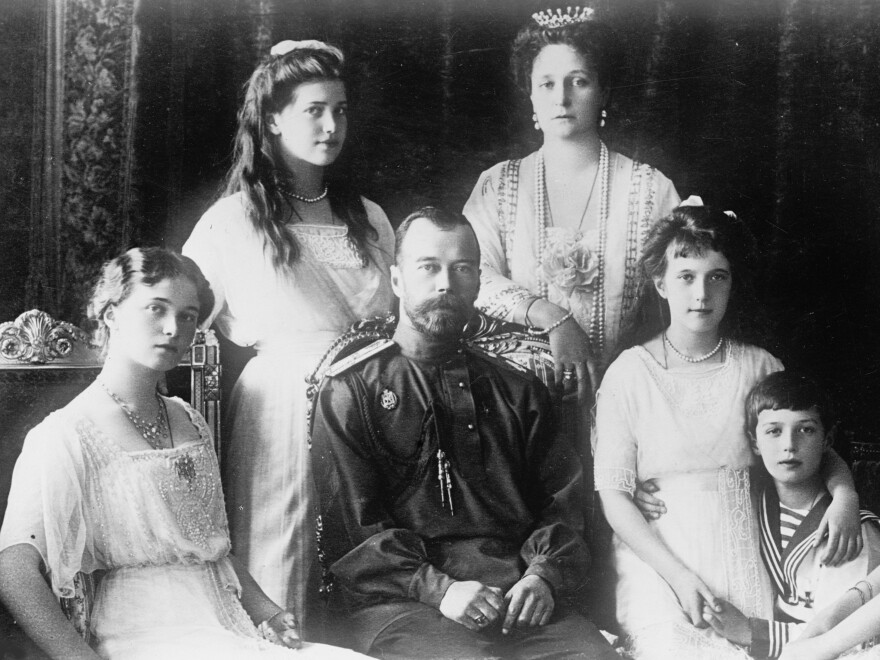With our free press under threat and federal funding for public media gone, your support matters more than ever. Help keep the LAist newsroom strong, become a monthly member or increase your support today.
Will DNA Tests Finally Settle Controversy Surrounding Russia's Last Czars?

Russian investigators have opened the tomb of 19th century Czar Alexander III in search of evidence that may help confirm the remains of his grandchildren, who were executed shortly after the Russian Revolution.
Alexander III, who went by the title "Emperor and Autocrat of All the Russias," died in 1894. His reign was conservative and repressive, and may have spurred the discontent that eventually engulfed his son, Czar Nicholas II, in revolution.
The powerful Russian Orthodox Church requested Alexander's exhumation to establish DNA records of the royal house that was wiped out by the 1917 revolution.
According to the church, the investigation should establish — once and for all — the identity of remains believed to be those of Nicholas II, his wife, Alexandra, and their five children.
The entire family was executed by Bolshevik revolutionaries in 1918, but their burial place remained a mystery until 1991, when skeletal remains were found in a forest near Yekaterinburg, Russia. DNA tests at the time identified the family, but questions and uncertainty lingered, especially among Orthodox believers outside of Russia.

Many of them felt the process was too secretive, and they were unconvinced that the remains were really those of Nicholas, Alexandra and their daughters. A comparison with Alexander III's DNA could establish the family's genetic links from the grandfather through his children and grandchildren.
Many people thought the controversy was resolved in 1998, when the remains were given an imperial funeral, under political pressure, in a fortress in St. Petersburg.
Coffins said to contain the remains of Nicholas, Alexandra and three of their daughters were displayed on a dais, as incense wafted through the cathedral of Saints Peter and Paul.
Gold-clad priests led prayers for the souls of the deceased — but the church itself was never entirely convinced that the remains were genuine.
"The identification that was made in the '90s considering the czar and his wife and some of his children actually was not recognized by the church," says Vakhtang Kipshidze, a church spokesman.
Among other things, he says, the church didn't consider the process of identifying the remains transparent enough.
The issue was complicated further in 2007, with the discovery of two more sets of remains in the woods in Yetkaterinburg, not far from the first burial place.
These were identified as Nicholas' younger children, Crown Prince Alexei and the Grand Duchess Maria. But identification was difficult because their killers had tried to destroy the corpses by dousing them with acid and then burning them.
Many Russian scientists and historians believe the remains are authentic, based on letters and reports from the revolutionaries themselves at the time of the executions and DNA tests carried out after the remains were found.
Some, like historian Yevgeny Pchelov, are uncomfortable with the idea of exhuming Nicholas' father in order to obtain DNA samples.
"Opening the tomb of Alexander III is, I would say, inappropriate," he says. "It's a cultural monument, it's the grave of an emperor, and to disturb the burial just to make sure, I think, is not quite justified."
But one thing that makes the issue so important to the Russian Orthodox Church is that the church canonized Nicholas and his family members in 2007.
"That means that [their remains] will be holy relics from our point of view," says church spokesman Kipshidze, "and they will be put for worship in some of our churches."
He says the church especially wants the remains of Crown Prince Alexei and Grand Duchess Maria to be subjected to the most rigorous and transparent investigation.
In addition to comparing DNA from Alexander III, investigators have other ways of tracing the family's genetic connections. Alexander III's father, Czar Alexander II, was assassinated by a revolutionary's bomb in 1881, and his bloodstained coat has been preserved.
Nicholas II was the target of an assassination attempt during a tour in Japan in 1891, before he became czar. His bloodied shirt was tested for DNA in 1993, but the results were inconclusive.
Historian Nikolai Svanidze says the current investigation isn't really necessary from a historical perspective, since most historians believe that identification of the remains has been satisfactorily settled.
He says the question now is mainly a political one about the church and its relationship to power — both the imperial power of the czars and the power of the current Russian government.
"The Russian Orthodox Church has always identified itself with the power," he says. "The only power it couldn't identify itself with was the Soviet one, though it tried, too. The imperial power and the post-Soviet Russian one saw the church as an ideological ally."
Copyright 2025 NPR







